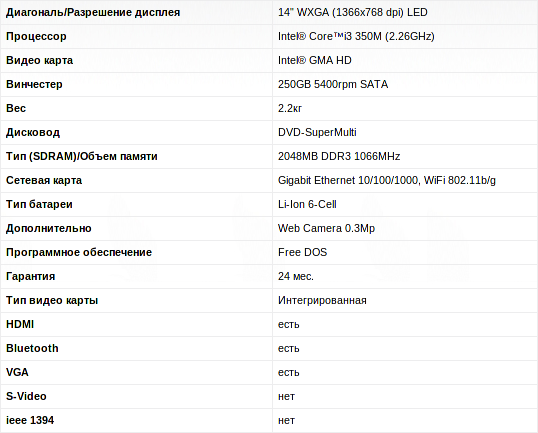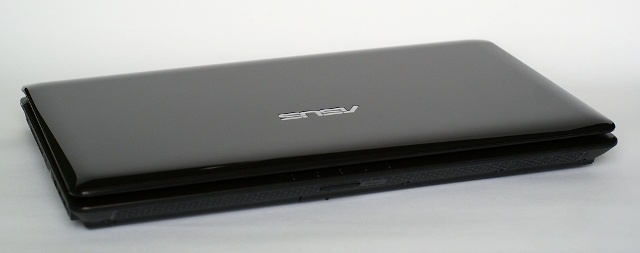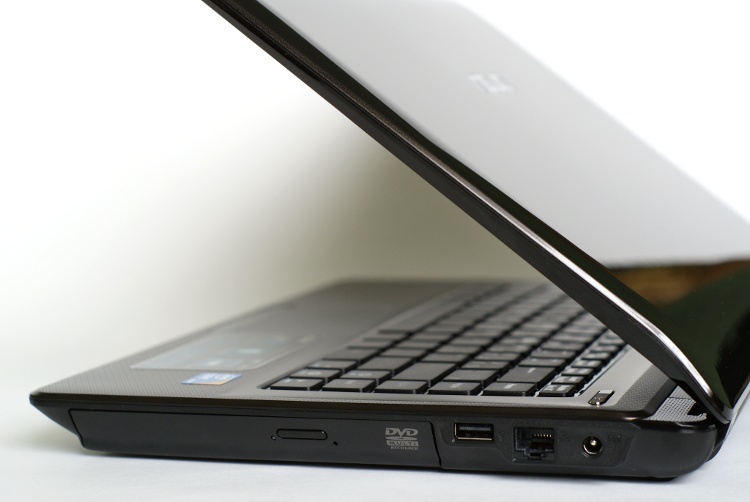ASUS K42F

I think many people know that at the beginning of this year, Intel introduced a new family of processors Core. These are its first solutions created by the 32-nanometer process technology, and also, they include an integrated graphics core.
ASUS is one of the first to launch a series of laptops with these processors. Recently on Habré was a review of K52, today, I want to tell you about my younger brother - ASUS K42F.
The K-series is an entry-level notebook, universal state employees.
Specification:

Appearance
K42F is very similar to K52, but there are some differences.
')

The top cover is traditionally made in gloss, which is decorated with the inscription ASUS. There are no switching ports in front, except for the SD / MMC memory card slot.

On the right are the power input, RJ-45 jack for the network, one USB and a DVD drive door.

On the left, there is a Kensington lock port, heat holes, a monitor output, an HDMI connector, two USB and a headphone jack.

I was very pleased that, as in the K52, the plastic surrounding the keyboard is not glossy , but made with fancy relief. The glossy has a double touchpad button and the space between the keyboard buttons, but it's not so scary.

The keyboard is standard, all the buttons are where you expect to see them (Fn is not extreme, as sometimes happens). In the process of typing, it bends a little, but not so much that it interferes with printing.

The laptop screen is of course glossy. In bright light and in the off state, I quite successfully managed to use it as a mirror.
Using
As an operating system, I use Ubuntu Linux version 10.04 beta1 x86_64. I put the beta as judging by the forums, 9.10 does not work correctly with the integrated video.
The installation took a little more than half an hour and did not bring any surprises. Almost all devices started from the box: video, sound, bluetooth, wi-fi, camera. Also earned keyboard shortcuts Fn.
Problems arose only with the card reader and headphone connection. If before the release it does not correct itself, then I will start digging, but for now laziness is the way I do not use it.
A little about the touchpad. Firstly, it is quite sensitive, secondly - it has additional features.
For example, to use scrolling, you need to slide the touchpad with two fingers horizontally or vertically. Sometimes it (scrolling) is buggy and at the time of releasing the finger, it twists back a little, but mostly it is quite convenient to use.
A two-finger click is recognized as pressing the middle button, it is convenient to use in Firefox (who does not know, by pressing the middle button on the link, it opens in a new tab).
A three-finger click is processed as a right-click (context menu).
I have no “Typing without errors” technology that should prevent accidental clicking on the touchpad during typing, I suspect that it is implemented by third-party software and only under Windows (TODO: make the touchpad turn off automatically when the mouse is connected or manually, because it’s bad) .
The nominal processor frequency is 2.27 GHz, but when the power of the laptop is not needed, it automatically decreases. For example, when typing this article, it almost all the time

Concerning performance , I’ll give tests from the Hardinfo utility (present in the repositories) and my own:
K42F
CPU Blowfish - 5.65
CPU CryptoHash - 221.52
Fibonacci CPU - 3,12
CPU N-Queens - 9.21
FPU FFT - 1.88
FPU Raytracing - 5.59
Archive unpacking ~ 900 Mb - 35 sec.
Processing ~ 150 Mb photo (SIC) - 1.05 sec.
Desktop (Core 2 Duo E6550 2.33GHz, ASUS P5K, DDR-II 1024MB 800Mhz)
CPU Blowfish - 7.51
CPU CryptoHash - 170.95
Fibonacci CPU - 4.51
CPU N-Queens - 9.77
FPU FFT - 3.89
FPU Raytracing - 19.55
Archive unpacking ~ 900 Mb - 45 sec.
Processing ~ 150 Mb photo (SIC) - 1.45 sec.
On account of the video. I don’t play games, so I didn’t need a high-performance video card, but even the existing one doesn’t do a bad job with Nexuiz.
Oh bad. Against the background of positive impressions about the laptop, the opinion about the matrix stands out quite sharply. Let it be glossy, but why, why such small vertical viewing angles ?! Maybe I'm too used to home CRT, but on the robot I use the usual widescreen TFT and the situation is much better!
The image looks most normal with the screen as wide as possible, then black is similar to black and a semitone gray is normally visible (for example # F9F9F9). But then black halftones completely merge into 100% black.
In a word, when editing a photo or other working with colors, you need to be very careful, but rather, use a normal monitor for this. Very disappointed.
The time of autonomous robots in standard mode (watching videos, music, surfing the Internet) is two and a half hours.
Finally
The laptop pleases with matte elements of the case, compactness, speed, but a little upset with the quality of the screen. Depending on the tasks, you should see whether it suits you or not.
PS
I could not put up with the screen and today I returned the laptop. I want to say thank you to the managers who were not very angry.
Source: https://habr.com/ru/post/89154/
All Articles